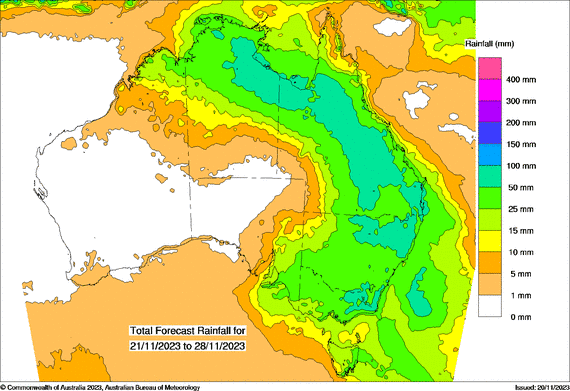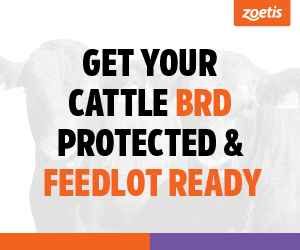A CHANGE in the weather pattern since early November may have come too late to have any material impact on direct consignment slaughter cattle offers for the remainder of this year.
Recordings of 25-75mm were reasonably common across parts of southern and southeastern Queensland and northwestern NSW over the past week, adding to earlier falls. Up to 150mm was recorded in pockets.
Another enormous rainband is evident in BOM’s current eight-day forecast, anticipating another 25-50+mm across most of Queensland, NSW and Victoria, as well as the top half of the Northern Territory (see 8-day BOM map below).

As a result, small green sprouts of confidence have returned in many beef producers’ mindsets.
Physical saleyards and online marketing platforms have all shown a sharp rise in store and slaughter descriptions over the past fortnight.
Heavy flatback feeder steers in the paddock are suddenly worth 265c/kg delivered downs this week, having made only 220-230c as recently as three weeks ago. Some pretty lines are making as much as 300c, Beef Central was told.
The Eastern Young Cattle Indicator reached another recovery milestone yesterday, topping 450c/kg (dressed weight equivalent) yesterday for the first time since the drought impact really started to bite in early September.
Virtually all young cattle and breeder descriptions offered on AuctionsPlus on Friday displayed sharp rises in value. Steers 280-330kg online on Friday averaged 312c/kg, up 64c/kg in a week, while heavier steers 330-400kg were +47c, averaging 288c. It was a similar story among heifers, where 200-280kg lines averaged 293c, up 62c on the previous sale.
In the saleyards channel, all sales reported earlier this week have been impacted by rain.
 Gunnedah yarded a much smaller offing of 700 yesterday after widespread local rain. Slaughter types were in limited supply, but there were dearer trends throughout the yarding. Well-finished grown heifers and mediumweight cows were dearer, while better-finished heavy cows experienced little change.
Gunnedah yarded a much smaller offing of 700 yesterday after widespread local rain. Slaughter types were in limited supply, but there were dearer trends throughout the yarding. Well-finished grown heifers and mediumweight cows were dearer, while better-finished heavy cows experienced little change.
Wodonga this morning saw a reasonable offering of outstanding bullocks and trade cattle change the tempo of the sale, with all buyers keenly seeking finished stock. The standout of the sale was bullocks and cows with bidding intensifying for all weights and grades. Cattle in the export categories jumped 15-19c/kg, with a bigger group of buyers present Heavy steers and bullocks sold from 194-241c/kg. Heavy cows ignited the bidding which, led to further increase in prices of 23c/kg fetching from 190-220c/kg. Plainer grades sold from 155-185c.
It’s a different story for direct consignment cattle, however, where there has been little change in offers for the past two to three weeks. The overwhelming reason for that is that processors are already heavily subscribed with cattle booked at a price for kills between now and Christmas closure.
With numbers already heavily committed for the remaining four weeks of processing operations for 2023, some processors are now only looking for a few thousand to slot into the last week’s kills, commencing 11 December.
Listed in a separate item today is a summary of 2023 closure dates and prospective 2024 opening dates for 30 major beef processors across the eastern states.
Grids unchanged
This week’s rain has again caused a few disruptions for processors, but many have juggled other cattle around to suit. Any delays will be for only a few days, unless further rain sets in, Beef Central was told.
While there have been a few ‘plus 10c’ offers thrown around early this week to get things moving, the official direct consignment offers from large Southern Queensland processors this week still have four-tooth grass heavy steer with an implant from 415-440c (some offers 10c higher for HGP-free cattle) and heavy boner cows 355-360c/kg. Other competitors are not offering grid prices at all, knowing they have requirements for 2023 already covered.
Most Central Queensland operators are 10c behind those in southern parts of the state, while North Queensland is 25c behind the southern regions.
Southern states processor offers are also little changed this week.
In eastern parts of South Australia, active quotes this week have four-tooth grass ox on 415c/kg, and 360c/kg on heavy cows, while southern NSW has PR grass steers on 395c/kg and 300c on cows, although the cow demand is currently limited, at best.

As the time period to booking cattle in to when they get processed has been up to six weeks I would not be surprised if we see processors scrambling for cattle should a widespread rain event happen.
People I talk to at the moment seem to have little regard for the processors when they have dropped the price so much with the only reason being, because they can and thus will not have a second thought to cancelling their booking if they think they can now hold them until next year when the price might be better as the prices offered at the moment are entirely unsustainable for producers given the increases in input costs. The processors have burnt some bridges that is for sure.
The current situation with high input costs and continue to rise at the same time livestock price collapsing needs to be looked at at all levels. Many farmers carrying large loans are faced with doubling of interest rates with over 50% income loss coming next review with there bank will make many farmers unable to refinance with the 3% buffer. This should not apply to business already in the loans processors are making a massive profit at present buying for not much and selling at normal prices .